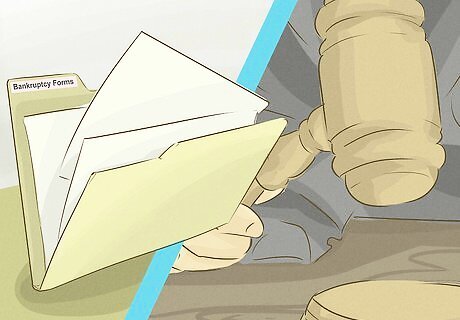
views
X
Research source
Implied contracts can even be created by your actions alone.[2]
X
Research source
Anyone can create an implied contract, but implied contract lawsuits are often brought by an employee who has been fired. The employee will claim that they had an implied contract and that the firing violates that contract, or the employee can claim that he is entitled to a benefit that you refuse to provide. To defend against an implied contract claim, you need to review your communications and actions before seeking the advice of a lawyer.
Proving No Implied Contract Exists

Identify the elements of the legal claim. A lawsuit for breach of an implied contract is not much different than a lawsuit for breach of an express contract. The plaintiff typically must prove: the existence of an enforceable promise between the two parties the plaintiff’s performance of all conditions or a valid reason why he or she couldn’t perform the defendant’s failure to adequately perform resulting damage

Read the complaint. When someone sues you, they will file a complaint in court. In this document, the person explains the factual circumstances of the dispute, identifies the legal theories that support their claim, and makes a demand for relief (usually money). You will receive a copy of the complaint with a summons. Read both documents carefully. Identify what language or actions the person has singled out as creating the implied contract. This is the first element that the plaintiff must prove—that a valid, enforceable promise was made. Highlight what evidence the plaintiff points to. Also note the respond date on the summons. This document should tell you how much time you have to respond to the complaint.

Review manuals and employee handbooks. You might have created an implied contract in your employee manuals and handbooks which explain company policies like pay, vacation time, and benefits. These documents can begin to look like promises. Take out any manuals and handbooks and review them. Look for a clear promise. The promise made in the handbook or manual will have to be sufficiently clear that an employee would reasonably believe a contract is being formed. Look for words like “shall,” “never,” and “must.” For example, “An employee shall receive four hours of personal time for each 80 hours worked” sounds like a promise. Ideally, you should have used the term “at will” repeatedly throughout the handbook or manual. By using this language, you can prevent the employee from believing that the manual is creating a contract.

Preserve your communications. You can create an implied contract through any communication with a person. In the employment context, you should review all of your communications with the employee. Implied contracts can be created in the following ways: Orally. In an interview, you might promise that an employee will receive a pay raise each year. This can create an implied contract that the employee will receive the pay raise as a matter of right. Through the offer letter. Some employers send out a letter to new hires in which they confirm the starting date. You should look at your offer letter and see if you made other promises in it. You should have mentioned that the employment is “at will” and also defined what that term means. You can also create an implied contract through the offer letter by stating a yearly salary. This can create the impression that the person is guaranteed employment for a full year. Instead, you should list salary in pay period increments. You should also have stated that employment was conditional on other factors, such as signing a non-disclosure agreement. If you did not, then you might have created an implied contract. Through custom. When your repeated conduct creates a reasonable expectation of a benefit, then a court might find that an implied contract exists. For example, if you repeatedly allow employees to take the company car home, then a reasonable employee might assume this is a benefit of the job.

Meet with an attorney. At a minimum, you should consult with an attorney who can advise you about the best defenses that you have. To find an attorney, you should contact your local or state bar association, which should have a referral program. You might not want to pay the legal fees for a lawyer. However, you should realize that in most states you don’t need to hire a lawyer to take over the entire case from you. Instead, you could meet with a lawyer for a half-hour consultation. Or you could contract with an attorney to provide legal advice only on an as-needed basis. This is called “limited scope representation.” You should call an attorney and ask if he or she offers this service. You can also read Find a Good Attorney, which has tips for finding a qualified attorney.

Come up with your defenses. If you are sued, then you will need to come up with your theory of defense as soon as possible. You can defeat this claim by casting doubt on how clear the language or conduct was. In short, you argue that no contract was created. For example, you might argue that although you gave your employee a bonus two Christmases in a row, no reasonable person would understand this bonus as a contractual entitlement. You also might argue that the contract had to be in writing. In most states, certain contracts cannot be oral. For example, in Illinois, contracts must be in writing for the sale of land, for agreements to pay another person’s debts, an agreement to marry, and any agreement that cannot be performed within a year. If the plaintiff’s alleged implied contract was created only by words and falls into one of these categories, then you can argue that it is not valid. You can also defend against this claim by attacking the other elements a plaintiff must prove: that he or she performed their promise under the contract and that they suffered damages as a result of your breach. The plaintiff’s performance. Even if the plaintiff can show that an implied promise was made, you could counter that the plaintiff never performed his or her own obligations. In the employment context, you could argue that the employee’s performance was so bad that he deserved to be fired for cause. Damages. You might also argue that the plaintiff didn’t really suffer any damage. For example, the plaintiff might have been able to buy whatever you promised to sell from a different seller for a cheaper price. In this case, the plaintiff suffered no damages.
Defending Yourself from a Lawsuit

Draft an answer. You will respond to the complaint by drafting an answer. In this document, you will admit, deny, or claim insufficient knowledge to admit or deny each allegation. You can also raise any affirmative defense. With an implied contract claim, the most relevant affirmative defense would be that the plaintiff violated the statute of limitations by waiting too long to sue. Search the Internet for “contract statute of limitations” and your state to find the applicable statute. Many courts now have blank answer forms that you can use. Ask the court clerk if one is available. If the court doesn’t have a blank form, then you can visit a legal aid office. Some legal aid offices have created “fill in the blank” forms for people to use. To find a legal aid office near you, visit the Legal Services Corporation’s website at www.lsc.gov. You can also use a CD or book of legal forms to help you draft an answer. See Format a Legal Pleading for tips on how to make the answer look right.

File the answer. When you complete the answer, you should make several copies. Take the copies and the original to the court where the plaintiff filed the lawsuit. Ask the court clerk to file. The court clerk should stamp all of your copies with the filing date. You have to send the plaintiff a copy of your answer. If the plaintiff has a lawyer, the lawyer should get the copy. If the plaintiff has no attorney, then the plaintiff will receive the copy. Look at your complaint to see if the plaintiff has a lawyer. You can serve a copy of the answer in a variety of ways. For example, you can typically have someone mail it to the plaintiff or hand deliver it. Ask the court clerk for acceptable methods of service.

Engage in fact-finding. After you file an answer to the complaint, the lawsuit will enter the fact-finding phase. This is called “discovery.” During discovery, you and the plaintiff will exchange relevant documents and ask each other questions, either in writing (using “interrogatories”) or orally (during a deposition). You should think strategically about what information would be helpful to defending against an implied contract claim. For example, you might want to get the employee to admit during a deposition that she continued to look for employment even after the purported implied contract was made. This evidence would show that she didn’t really believe that a contract had been formed with you. You also can defend a breach of implied contract claim by showing that the plaintiff didn’t perform his obligations under the contract. For example, you could show how the employee’s performance was terrible. Get the employee to admit during the deposition to the mistakes they made, as well as what reprimands they received. You also should get evidence of damages. If the plaintiff claims you promised to sell him a car, then try to get evidence that the plaintiff purchased a car shortly thereafter for a cheaper price than what you allegedly promised to charge.

Turn over documents. As part of discovery, you also need to turn over requested documents. In the employment context, you will probably need to hand over copies of employee manuals and handbooks, offer letters, and any email communications you have had with the employee. You must turn these documents over, and you should preserve any documents or information that relates to the lawsuit as soon as you receive the complaint. A court can sanction you if you destroy or lose relevant information.

File a motion for summary judgment. At the close of discovery, you can file a motion for summary judgment which argues that there are no material facts in dispute. You also argue that there is no reason to go to trial because the facts and law are so one-sided in your favor. A summary judgment motion is technical and requires extensive familiarity with your state’s law on implied contracts. You are unlikely to be able to learn this area of law on your own in such short time. If you want to file a motion for summary judgment, then you should hire a lawyer to write one for you.
Going to Trial

Arrive on time. You don’t want to be late for your trial. If you are, then the plaintiff could get a default judgment against you. Although you can sometimes get default judgments set aside, it can be difficult. Aim to get to the courtroom with at least 15 minutes to spare. Schedule sufficient time to pass through courthouse security after finding parking. Before entering the courtroom, you should turn off cell phones and pagers. Also turn off any watch that might make a beep or other noise.

Choose a jury. You will have the option of having your case heard by the judge. However, if either you or the plaintiff want to have a jury, then you will pick the jury. The jury selection process is called “voir dire.” During voir dire, the judge asks prospective jurors questions to uncover whether or not they can be impartial. You (or your lawyer) will be able to ask the judge to strike jurors from the panel for being biased. You also should be given a certain number of peremptory challenges. With these, you do not have to give a reason for striking the juror (though you cannot be motivated by racial, ethnic, or sexual bias). You might also be able to give the judge questions to ask—or possibly even ask the jurors questions yourself. In order to uncover whether jurors can be impartial, you should ask whether they have ever been sued before or whether they have ever sued for a breach of contract. Jurors who have had to defend themselves against a contract lawsuit might be more sympathetic to you, whereas jurors who have brought these types of claims could be more sympathetic to the plaintiff.

Deliver your opening statement. Each side is allowed to make an opening statement. You should briefly lay out a roadmap for the jurors as to what evidence you will present and what this evidence will prove. As the defendant, you will present your opening statement second. For example, in your opening statement you would want to tell the jury relevant facts: “On May 15, I interviewed the plaintiff at my office. And as the evidence will show, I made no promise of employment at that time. It was only later, on May 31, that I sent an offer letter to the plaintiff. As this letter will show, I clearly highlighted the fact that the plaintiff was an ‘at will’ employee. We had no other communication before she accepted the job.”

Examine the plaintiff’s witnesses. After opening statements, the plaintiff will present witnesses and evidence first. You will want to undermine the jury’s confidence in the witness’s testimony. You can accomplish this by highlighting how inconsistent the witness’s testimony is. For example, you can confront the witness with an inconsistent statement the witness gave during his or her deposition. For example, the plaintiff might state on the witness stand that he thought he had a contract to buy your car. However, in his deposition, he might have stated that he stopped by several dealerships after the conversation he believes gave rise to the contract.

Present your witnesses and evidence. You will present your case second. To help prove that no implied contract was created, you should present evidence that shows no promises were made. As an example, you could introduce into evidence your employee manuals and handbooks which show that you repeatedly state all employment is “at will.”

Deliver your closing argument. After both sides have presented their case, you will give a closing argument to the jury. Your goal is to review the evidence and argue to the jury that the plaintiff did not prove his or her case. As you prepare your closing argument, you should look at the pattern jury instructions, which will be given to the jury. Look to see what the instructions state the plaintiff must prove in order to create an implied contract. In your closing argument, you can argue that the plaintiff failed to prove one or all of these required elements. For example, you can remind the jury that the plaintiff didn’t perform his obligations under the implied contract, or that he didn’t suffer any damages.

Wait for the jury’s verdict. After the judge reads the jury its instructions, the jury retires for deliberation. In most states, the jury no longer must be unanimous to hold you liable for breach of an implied contract. Instead, the plaintiff could win if nine or more (out of 12) jurors decide against you.

Consider bringing an appeal. You might want to appeal the jury’s decision if you lose. You should talk this over with a lawyer. Appeals can be time-consuming and costly. Although you may have represented yourself at trial, you really need a lawyer to bring the appeal for you. If you decide to appeal, then ask the court clerk for a Notice of Appeal form. You shouldn’t wait. Typically, you have only 30 days or so from the date the court enters judgment against you in which to appeal.




















Comments
0 comment